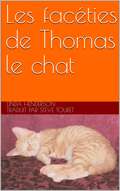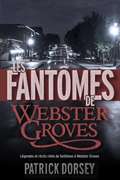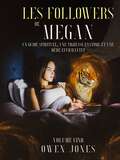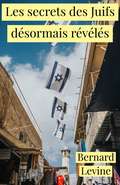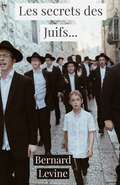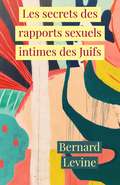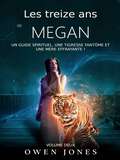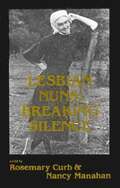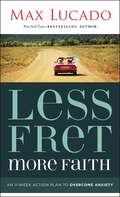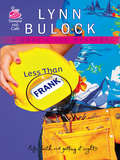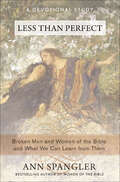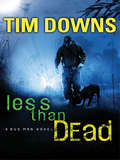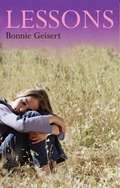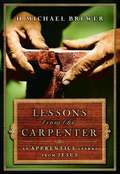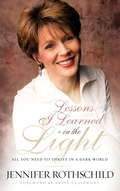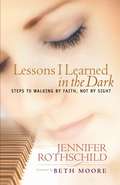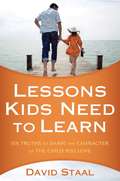- Table View
- List View
Les facéties de Thomas le chat
by Linda HendersonThe ever lovable Thomas finds himself on a new adventure of self discovery. Along the way, he meets many interesting animals, and can't help but wonder which animal he will most resemble after he's all grown up.Your child will be fascinated with the unusual creatures Thomas encounters. Who else but a wise old owl reveals to Thomas his true identity. This book will enlighten the mind of any child between the ages of 3-9. L'adorable Thomas se retrouve dans une nouvelle aventure à la découverte de lui-même. Sur le chemin, il rencontre d'intéressants animaux et ne peut s'empêcher de se demander auquel il ressemblera le plus lorsqu'il sera adulte. Votre enfant sera fasciné par les créatures insolites que Thomas rencontre. Qui d'autre qu'un sage hibou pour révéler la vérité à Thomas au sujet de sa véritable identité ? Ce livre éclairera l'esprit de chaque enfant âgé de 3 à 9 ans.
Les fantômes de Webster Groves: Légendes et récits réels de fantômes à Webster Groves (Missouri, USA)
by Patrick DorseyWebster Groves – Un endroit fabuleux pour vivre, travailler et s'amuser… même pour les trépassés… Nous avons tous été un jour ou l’autre troublés par les histoires terrifiantes de maisons hantées ou de fantômes, ces âmes en peine ou esprits non apaisés qui perturbent le quotidien des vivants jusqu’au plus profond de leur vie privée. Ces légendes, ces films d’épouvante, vous les connaissez sans doute, et peut-être avez-vous même entendu une connaissance, peut-être même un voisin de palier, vous confier qu’il a lui-même rencontré un fantôme. Ce livre vous propose de découvrir non seulement des légendes, mais aussi des récits de première main parlant de personnes comme vous et moi, des habitants de quartiers paisibles et tranquilles, qui ont un jour été tirés de leur sommeil par des bruits inexpliqués, ou détournés de leurs activités par une présence sur les escaliers ou par des objets qui disparaissent ou se déplacent mystérieusement ; des personnes somme toute normales, qui ont appris à s'accommoder avec les entités ou autres apparitions spectrales qui rodent dans leurs maisons et partagent leur quotidien. Webster Groves, dans le Missouri, fait partie des banlieues les plus anciennes de St. Louis, avec une histoire qui remonte à la période coloniale et à la Guerre civile américaine. Un passé dont les témoins désincarnés habitent visiblement encore aujourd’hui entre les murs de certaines anciennes bâtisses…
Les followers de Megan: Un guide spirituel, une tigresse fantôme et une mère effrayante! (La série Megan #5)
by Owen JonesLes followers de Megan Un guide spirituel, une tigresse fantôme et une mère effrayante! Megan est une fille de 13 ans avec des pouvoirs surnaturels. Certains d’entre eux ne sont encore que partiellement développés et d’autres fonctionnent, mais elle ne sait pas comment les utiliser pour le moment. Ses plus gros problèmes du moment sont, d’une part, de trouver un professeur qui peut lui montrer comment les utiliser proprement, et d’autre part, elle ne connaît personne qui connaisse quoi que ce soit par rapport aux pouvoirs surnaturels. En fait, sa mère est violemment contre le surnaturel, comme c’était le cas de sa mère avec elle-même. Les seules personnes qui semblent partantes pour l’aider sont mortes, même si cela ne fait aucune différence pour Megan. Elle accueille leur aide à bras ouverts. Les followers de Megan fait référence à ses abonnés sur Internet. Depuis qu’elle a tout juste 13 ans, ses parents et les sites multimédias lui permettent désormais d’utiliser ces derniers. Alors, elle s’ouvre des comptes sur Twitter, Facebook et LinkedIn. Wacinhinsha lui enseigne la communication et la façon dont cela peut être perçu par un guide spirituel.
Les hauts et les bas de Fish (Orca Currents en Français)
by Joanne LevyFishel (Fish) Rosner, douze ans, n’aime pas les activités qui plaisent généralement aux garçons. Il déteste les sports et préfère lire ou faire du bricolage plutôt que de grimper aux arbres ou de faire du vélo de montagne avec ses amis. Il aime aussi danser. Tout ce qu’il aime est considéré comme des passe-temps de « filles », mais Fish ne comprend pas pourquoi ce serait une mauvaise chose. Il s’intéresse simplement à des activités différentes des autres garçons. Quand il demande à sa Bubby de lui enseigner le tricot, elle lui dit d’aller jouer dehors. Quand il insiste pour que sa mère l’amène au cours de zumba, elle l’inscrit plutôt au water-polo. Pourquoi tout le monde décide-t-il ce que Fish doit faire ou ne pas faire?
Les secrets des Juifs désormais révélés
by Bernard LevineVous l'avez demandé, à la demande générale, voici d'autres secrets de la vie et des coutumes des Juifs. Que font les Juifs chez eux tous les jours ? Que mangent-ils ? Comment observent-ils le sabbat ? Quelles sont les fêtes juives et bien plus encore ! Vous trouverez de la révélation et vous prendrez un grand plaisir à découvrir les secrets cachés de ce qui se passe dans le monde juif.
Les secrets des Juifs...: Ce que les chrétiens ne savent pas de la religion, des traditions et du mode de vie juifs
by Bernard LevineJésus-Christ (lui-même Juif) était contre les traditions juives car les lois faites par les Rabbins Juifs sont un lourd fardeau pour les Juifs qui ne peuvent pas les observer entièrement. Non seulement les Juifs doivent obéir aux saintes lois de Dieu telles que consignées dans les Écritures, mais ils doivent également obéir et respecter toutes les lois faites par les Rabbins. Si seulement les Juifs savaient que Dieu ne punit personne pour une simple déchirure de papier toilette le jour du Sabbat et que, pour les Juifs, consommer des hamburgers au fromage et de la viande combinée à un produit laitier au cours d’un même repas n’expose à aucune sanction. Je suis tellement béni et je n'ai pas à me demander, comme le font les Juifs, qui est le vrai Messie. Des centaines de prophéties bibliques se sont déjà réalisées qui prouvent que Jésus-Christ est le Messie. Je suis si profondément reconnaissant; je jouis de l’immense privilège d'avoir été libéré de l'obligation de respecter les 613 lois de l'Ancien Testament et de pouvoir vivre par la grâce de mon Seigneur et Sauveur, Jésus-Christ.
Les secrets des rapports sexuels intimes des Juifs
by Bernard LevineEst-il vrai que les Juifs ont des rapports sexuels à travers le trou d’une feuille ? Que font les Rabbins des prépuces coupés ? Pourquoi les Juives doivent-elles présenter leurs dessous à un Rabbin ? Saviez-vous que le Rabbin suce le sang du pénis circoncis d'un bébé ? Avez-vous appris qu'il existe une manière spéciale pour les Juifs de porter leurs chaussures ? Pourquoi les Juifs prennent-ils un poulet vivant qu’ils balancent par-dessus leurs têtes ? Pourquoi les Juifs enterrent-ils leurs assiettes? Vous serez choqué par les étranges pratiques de la communauté juive.
Les treize ans de Megan: Un guide spirituel, une tigresse fantôme et une mère effrayante ! (La série Megan #2)
by Owen JonesLes treize ans de Megan Un guide spirituel, une tigresse fantôme et une mère effrayante ! Megan est une fille avec des pouvoirs surnaturels et parapsychologiques qu’elle ne comprend pas pleinement. Elle est constamment à la recherche de quelqu’un pour la conseiller dans la façon de les développer, mais les seules personnes qu’elle connaît qui sont capables de l’aider sont mortes. Par contre, cela n’empêche pas Megan de chercher de l’aide. Dans cette histoire, il s’agit de l’anniversaire des treize ans de Megan. Les parents de Megan l’emmènent magasiner, où il se produit un incident dont Megan aide à rectifier. Le personnel de la police et de l’ambulance la remercie. Il s’agit de sa première fois où elle utilise ses pouvoirs pour quoi que ce soit d’utile. Plus tard, dans l’après-midi, il y a une fête familiale sous un chapiteau, mais c’est au cours de la soirée avec ses amis qu’elle a vraiment hâte. Là, elle y rencontre un garçon et reçoit son premier baiser d’une personne non apparentée. Dans cette édition, elle grandit un peu plus vite que quiconque ne s’y attendait !
Les égarés de Noël
by Rachelle Ayala« Une histoire touchante d'amour et de miracles » - Chantel Rhondeau, auteure de best-sellers Juliette ne veut plus jamais célébrer Noël. Pas quand cela lui rappelle le dernier Noël de son fils de six ans, Jeremiah, décédé la veille de Noël. Elle et son mari Gabe se retrouve coincés dans un chalet de montagne avec deux petits égarés, après une tempête de neige. Juliette a désespérément besoin d'un miracle pour sauver son mariage et pour restaurer sa foi en Dieu. Un chine errant et un orphelin arriveront-ils à aider Juliette à croire à nouveau en la magie de Noël et au pouvoir de l'amour ?
Lesbian Nuns: Breaking Silence
by Rosemary Curb Nancy ManahanIn these unique and compelling revelations, both ex-nuns and present nuns unlock the most secret doors in their closed and mysterious communities. Under rigidly enforced rules of behavior, where women's lives are consecrated and subjugated to the most sacred of vows, where "particular friendships" are ruthlessly eradicated under pain of sin and expulsion, still the power of love manages to emerge and survive. Each nun in these stories describes the infividual and searing path she has journeyed to discover and face and experience the truth of herself: that she is a Lesbian nun.
Lesbian Rabbis: The First Generation
by Rebecca T. Alpert Shirley Idelson Sue Levi ElwellStories of eighteen lesbian rabbis.
Less Fret, More Faith: An 11-Week Action Plan to Overcome Anxiety
by Max LucadoA pass-along companion to Anxious for Nothing that features an 11-week plan to overcome anxiety.According to one research program, anxiety-related issues are the number one mental health problem among women and are second only to alcohol and drug abuse among men. Stress-related ailments cost the nation $300 billion every year in medical bills and lost productivity. And use of sedative drugs like Xanax and Valium have skyrocketed in the last 15 years. Even students are feeling it. One psychologist reports that the average high school kid today has the same level of anxiety as the average psychiatric patient in the early 1950s. Chances are, you or someone you know seriously struggles with anxiety.Max writes, "The news about our anxiety is enough to make us anxious.” He knows what it feels like to be overcome by the worries and fear of life, which is why he is dedicated to helping millions of readers take back control of their minds and, as a result, their lives.This 64-page booklet features practical steps from Max Lucado to help readers overcome anxiety. Eleven weekly reminders in all, each segment includes a Scripture verse for meditation, and a prayer to reframe anxious thoughts.This booklet includes a passage from the book, Anxious for Nothing, by New York Times bestselling author Max Lucado. The small trim and low price point make this booklet easy to share with friends and family who are struggling with anxiety and need a fresh perspective on how to face it.Stop letting anxiety rule the day. Join Max on the journey to true freedom and experience more joy, clarity, physical renewal, and contentment by the power of the Holy Spirit. Anxiety comes with life. But it doesn't have to dominate your life.
Less Than Frank
by Lynn BulockMy new job: Gracie Lee Harris, dead body finder. First, my con-man husband. Now, Frank, the no-good contractor renovating my apartment. Frank was less than, well, frank, with people; now someone has made sure he's less than alive. And I think Ray--uh, Detective Fernandez--is starting to wonder about me, since I'm always sticking my nose into his homicide investigations. That could be the reason he keeps coming to question me. . . . They say God doesn't give us more than we can handle, but I wish He didn't think I could handle so much!
Less Than Perfect: Broken Men and Women of the Bible and What We Can Learn from Them
by Ann SpanglerWhat can the Bible&’s most flawed men and women reveal about who God is and how he reaches out to less-than-perfect people? In Less Than Perfect, bestselling author Ann Spangler takes us beyond cardboard cutouts of 38 biblical characters to show us how these were real individuals who had dreams, temptations, and weaknesses just like us.Whether considering the murderous Herodias, the scheming Jacob, or the doubting Sarah, Spangler approaches both familiar and lesser known characters with fresh eyes. We meet each of these individuals again as if for the first time as Spangler offers a dramatic retelling of their lives, insight into the historical and cultural context of their time, and key takeaway points for our lives today. Each chapter includes questions for discussion or reflection, making Less Than Perfect ideal for individual or group Bible study.Entertaining, informative, and inspirational, Less Than Perfect gives you a big picture view of the Bible even as it takes you into the hearts and minds of people with struggles just like yours. As you learn more about the individuals who are part of your spiritual family tree, you&’ll discover why God loves to use imperfect people to tell his perfect story of redemption.
Less than Dead
by Tim DownsDogs have long been manÆs best friend, but the Bug ManÆs friends is a rare breed . . . the cadaver dog. All roads lead to the White House for John Henry Braden, the charismatic senator from Virginia aristocracy whose beautiful wife Victoria is the talk of Washington and the crown jewel of Endor, her backwoods Virginia hometown. But when bodies turn up on BradenÆs propertyùthe site of a multimillion dollar construction project heÆs spearheadingùthe senatorÆs spin doctors, led by his future first lady, must act quickly to quell a conspiracy before it blemishes their presidential campaign. Enter entomologist Nick Polchak, the quirky bug expert enlisted to determine if the senatorÆs bone yard is a forgotten cemetery or a crime scene. To help with the investigation, Polchak follows local legend to Alena Savard, a mysterious woman known for her ability to turn mongrels into the best search dogs around. They soon find themselves on the trail of a desperate individual bent on protecting a terrible secret. Less than Dead is an unforgettable tale of crime and concealment in the corridors of high-stakes politicsùas well as in the deepest contours of the human heart.
Less than Dead
by Tim DownsDogs have long been man's best friend, but the Bug Man's friends is a rare breed . . . the cadaver dog. All roads lead to the White House for John Henry Braden, the charismatic senator from Virginia aristocracy whose beautiful wife Victoria is the talk of Washington and the crown jewel of Endor, her backwoods Virginia hometown. But when bodies turn up on Braden's property--the site of a multimillion dollar construction project he's spearheading--the senator's spin doctors, led by his future first lady, must act quickly to quell a conspiracy before it blemishes their presidential campaign. Enter entomologist Nick Polchak, the quirky bug expert enlisted to determine if the senator's bone yard is a forgotten cemetery or a crime scene. To help with the investigation, Polchak follows local legend to Alena Savard, a mysterious woman known for her ability to turn mongrels into the best search dogs around. They soon find themselves on the trail of a desperate individual bent on protecting a terrible secret. Less than Dead is an unforgettable tale of crime and concealment in the corridors of high-stakes politics--as well as in the deepest contours of the human heart.
Lessons
by Bonnie GeisertSummer was drawing to a close, and Rachel would soon return to school to begin fifth grade. Like many of her classmates, she was anxious about her friends, the strict Mrs. Kelly, and the timed arithmetic tests, but there was something else worrying Rachel, too. Ever since her baby brother, Matthew, was born, she couldn't help but notice that her father seemed even more brooding and withdrawn than ever. Confused and concerned by his behavior, Rachel starts demanding answers--but the secret she uncovers raises more questions than it solves. Author Bonnie Geisert transports readers back to a simpler time and place. Yet life on a rural South Dakota farm in the 1950s was not without its challenges, and Rachel soon discovers she has many lessons to learn, both in Mrs. Kelly's classroom and beyond . . . AGES 8-12 Grades 3-7 AUTHOR Bonnie Geisert grew up on a farm near Cresbard, South Dakota, and her childhood adventures there inspired many of the events in her Prairie trilogy.
Lessons From a Third Grade Dropout
by Rick RigsbyGo from making an impression to an impact.Six simple lessons modeled by an uneducated man were powerful enough to produce a Ph.D., a judge, and a lifetime of wisdom. Imagine how these lessons will impact you!
Lessons From a Third Grade Dropout: How The Timeless Wisdom Of One Man Can Impact An Entire Generation
by Rick Rigsby* USA Today and Wall Street Journal best seller* Be inspired by the book behind the graduation speech by Dr. Rick Rigsby – now with 200+ million views on Facebook and YouTubeReacquaint yourself with the wisdom of a generation gone by.We live in an era of low expectations. In fact, we tend to celebrate low expectations. The way in which we choose to live and work today is a far cry from the purposeful living of our parents.Have we reached the point in our society where it is more important to look good rather than be good? Has the pride in doing good work been replaced by self-entitlement, perfect offices, and slick suits?This book reacquaints readers with the wisdom—the common sense that was practiced simply and unwittingly by those who represent a generation gone by:A generation that worked hard without complaining.A generation that did whatever was necessary to support their families.A generation that took pride in doing a good job.A generation that had high expectations for themselves and the others they were responsible for.One such member of this generation was a third-grade dropout, a man who never hid behind any excuse. A man who never allowed his problems or lack of a formal education to determine his present or affect his future. A man who realized that destiny was a choice and not a chance.This book communicates lessons from that man’s life—the kind of wisdom that is rare in society today. It’s the kind of wisdom that will help you be a better person, a greater leader, a more effective worker.That man was Rick Rigsby’s father, and this book contains his impactful, far-reaching story—of how a life can be enhanced, of how a corporate culture can be changed, of how a family can be united—by living the simple lessons of a third-grade dropout.
Lessons From a Wandering Prophet: Discover the Keys to Growing in Your Call
by Hubie SynnFROM THE AUTHOR OF TALES OF A WANDERING PROPHETWhat happens when God&’s plans and your prophetic journey intersect?This book will help me grow in my prophetic gifts so that I can discover the plans that God has for me and move forward in my purpose. God has a plan and a future for each of us, but many people don&’t know what that plan is, and if they do, they don&’t know how to walk in it. Hubie Synn knows the feeling. Step by step, one adventure at a time, Synn has been discovering and growing in the prophetic gift God has given him—a gift that has taken him before celebrities, politicians, and power brokers, and even around the world. In Lessons From a Wandering Prophet, Synn shares the highs and lows he has experienced in ministry to teach principles of prophetic ministry: • How to discern when God is speaking • How to step out to say what God has given you to say • How to grow in the prophetic • What to do when a prophecy is not well-received • How to let go and let God lead you This book will inspire readers to receive with open hands and hearts the prophetic gifts God has given them, discover the plans God has for them, and walk fully in their calling.
Lessons From the Carpenter: An Apprentice Learns From Jesus
by H. Michael BrewerBefore Jesus was a teacher and a healer–before his life changed the world–he was a carpenter. Woodworking was his occupation for most of his time on earth, and the years he spent in Joseph’s shop clearly shaped his message and ministry. Now, by gaining an understanding of first-century carpentry, you can revolutionize your faith through the discovery of surprising insights into Christ’s life. The ministry of Jesus was spiritual carpentry. He rebuilt broken people and constructed a new world. His workmanship still amazes all who put themselves in his hands, and his principles for constructing a solid life are as relevant today as they were two thousand years ago. InLessons from the Carpenter,you can sit as an apprentice at the feet of this amazing master carpenter. And learn firsthand how he builds and rebuilds beautiful lives meant to last forever.
Lessons I Learned From The Lord
by Evelyn LangHave you ever wondered if God hears your prayers?Do you often fear you don't hear His voice when He is communicating with you?Through personal experience author Evelyn Lang shares the answers to these questions and much more. Among the topics coverd are: •How the Lord speaks to people in many different ways •How to trust more in the Lord •How to stop limiting Him and His plans for you •How to start believing He has miracles planned for them •How to experience the joy of the Lord as He reveals things to each person in the supernatural.This series of lessons, parables, and stories will help readers better understand that storms in life bring growth, how child-like faith allows people to have complete dependence and complete faith in the Lord. Lang admonishes everyone to be teachable for "the wise are teachable, the teachable become wise."
Lessons I Learned In The Light
by Jennifer RothschildGuidance for Your Journey Sometimes, God’s Word is like candlelight that warms and comforts. Other times, it is a red flashing light that protects. Often, it’s a spotlight that exposes your need. And since you are called to walk by faith, you need light-in all its various forms-guiding your steps. Jennifer Rothschild ’s path, darkened by physical blindness, is illuminated by scriptural truth. And now she shares the keys to persevering and “clinging to the Sword” no matter what your circumstances. Lessons I Learned in the Lightis a powerful collection of Scripture, intriguing autobiographical sketches, and pointed Bible study with personal, practical application questions that will encourage you every step of the way. “Your word is a lamp unto my feet, and a light unto my path. ” Psalm 119:105 Have you known darkness? Are you there even now? There is a ray of hope that brings clarity and guidance: God’s Word-the Light that is better than life. And it wields the power to see you through absolutely anything. Jennifer Rothschild , in her physical blindness, found the secret to persevering with endurance and shares it candidly. No matter what you face today,Lessons I Learned in the Lightwill help you: cling to His Word carry no baggage pray like crazy be God-conscious enjoy the fish bowl No matter how dark the road, you can travel it courageously, secure in the Light. “For these commands and this teaching are a lamp to light the way ahead of you” (Proverbs 6:23 , NLT). “Jennifer Rothschild is a sincere and transparent example of what it means to press toward the goal-to live a thriving, courageous life in Christ. ” Sara Groves Singer/songwriter “Like the Renaissance artists of old, Jennifer Rothschild sees with her heart. Through self-discipline, acute observation, and Christ centeredness, the tapestry of her life has been woven together by an unshakeable faith. ” Luci Swindoll Author and speaker, Women of Faith “Her gentle, pleasing style first draws readers in and captures their imaginations. Only then does she deliver her more powerful punches. " Publishers Weekly Story Behind the Book “I don’t have the privilege of reading God’s Word in the traditional sense, but I still rely on it as my source of power-power to persevere and thrive in a world of darkness. Without it, I would have quit a long time ago. Proverbs 6:23 says ‘These commands and this teaching are a lamp to light the way ahead of you’ (NLT). WhileLessons I Learned in the Darkprovided principles for walking by faith,Lessons I Learned in the Lightoffers fuel for running with endurance. ” - Jennifer Rothschild From the Trade Paperback edition.
Lessons I Learned in the Dark: Steps to Walking by Faith, Not by Sight
by Jennifer RothschildGuidance for Your Journey Sometimes, God's Word is like candlelight that warms and comforts. Other times, it is a red flashing light that protects. Often, it's a spotlight that exposes your need. And since you are called to walk by faith, you need light-in all its various forms-guiding your steps. Jennifer Rothschild 's path, darkened by physical blindness, is illuminated by scriptural truth. And now she shares the keys to persevering and "clinging to the Sword" no matter what your circumstances. Lessons I Learned in the Lightis a powerful collection of Scripture, intriguing autobiographical sketches, and pointed Bible study with personal, practical application questions that will encourage you every step of the way. "Your word is a lamp unto my feet, and a light unto my path. " Psalm 119:105 Have you known darkness? Are you there even now? There is a ray of hope that brings clarity and guidance: God's Word-the Light that is better than life. And it wields the power to see you through absolutely anything. Jennifer Rothschild , in her physical blindness, found the secret to persevering with endurance and shares it candidly. No matter what you face today,Lessons I Learned in the Lightwill help you: cling to His Word carry no baggage pray like crazy be God-conscious enjoy the fish bowl No matter how dark the road, you can travel it courageously, secure in the Light. "For these commands and this teaching are a lamp to light the way ahead of you" (Proverbs 6:23 , NLT). "Jennifer Rothschild is a sincere and transparent example of what it means to press toward the goal-to live a thriving, courageous life in Christ. " Sara Groves Singer/songwriter "Like the Renaissance artists of old, Jennifer Rothschild sees with her heart. Through self-discipline, acute observation, and Christ centeredness, the tapestry of her life has been woven together by an unshakeable faith. " Luci Swindoll Author and speaker, Women of Faith "Her gentle, pleasing style first draws readers in and captures their imaginations. Only then does she deliver her more powerful punches. " Publishers Weekly Story Behind the Book "I don't have the privilege of reading God's Word in the traditional sense, but I still rely on it as my source of power-power to persevere and thrive in a world of darkness. Without it, I would have quit a long time ago. Proverbs 6:23 says 'These commands and this teaching are a lamp to light the way ahead of you' (NLT). WhileLessons I Learned in the Darkprovided principles for walking by faith,Lessons I Learned in the Lightoffers fuel for running with endurance. " - Jennifer Rothschild From the Trade Paperback edition.
Lessons Kids Need to Learn: Six Truths to Shape the Character of the Child You Love
by David StaalDave Staal brings his experience as a parent and a nationally respected children’s ministry leader to help equip other parents and mentors to teach their children the most important lessons in life. With a dozen life-building lessons, parents and mentors will be able to teach their kids to have a balanced, healthy perspective about themselves and other people, and how to honor God with the way they live. Based on Staal’s own experiences as a parent as well as original research done nationwide through focus groups with parents and children, Lessons Kids Need to Learn is a valuable resource for parents, grandparents, teachers, children’s ministry workers, and mentors who care about teaching children how to live into their God-given identities.
